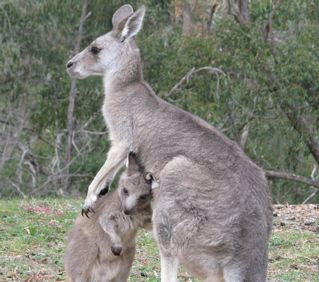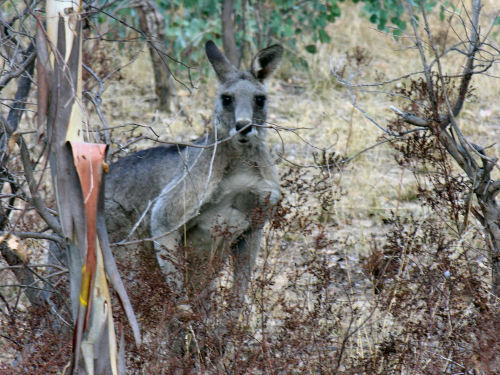Wildlife Research in Australia
(Photo by Sheila)
This article is a reflection on the nature and efficacy of wildlife research in Australia.
I raise 3 issues:
Can research benefit wildlife? Can research contribute to its survival? Can research engender respect for the intrinsic value of wildlife?

The Nature and efficacy of wildlife reseach in Australia
I’ve asked these questions because, despite over 200 years research into every aspect of the lives of our native animals, the many thousands of papers produced and the many millions of dollars spent, fauna populations continue to decline, the number of endangered and extinct species continues to rise and the attitude of the general public towards indigenous animals slides further into the abyss.
The current state of wildlife is desperate. It’s obvious that Australia is waging a war on wildlife. It’s a dirty war. It’s fueled by research and it will ultimately result in the destruction of all native animals.
You would think that our native fauna would be a precious and vital element of our country’s identity and that these animals would be nurtured and protected, not only for their value to the tourism industry or their role in the maintenance of biodiversity and the fragile ecosystem but for their sheer beauty and the elegance of the way they strive to survive in this harsh and dangerous land.

Two prevailing views
Photo provided by Nikki Sutterby, Co-Ordinator, Australian Society for Kangaroos
Unfortunately this is not the case. Very broadly speaking there are two prevailing views of the environment in Australia and I believe that wildlife research reflects and perpetuates these opposing points of view.
The majority view is that humans always have priority, with the right to live wherever, take whatever and do whatever they want.
Depending on who you are, wildlife is a resource to be exploited, a pest to be exterminated, or a curiosity to be dissected. For hunters and hoons, wildlife is fun to kill and for environmentalists it is sustainable food.
These beliefs are perpetrated by bureaucratic, short sighted, exploitative institutions and individuals who are always looking to maximize revenue, trade and profit. The research of selected experts is used to justify lethal management decisions and to excuse horrific cruelty to animals often by incompetent contract killers.
Taxes pay for this
Members of the CSIRO, National Parks, State and Federal Government agencies, councils, universities and agricultural colleges make up this group. Their work is often supported by the RSPCA and always paid for by the tax payer.
At the laboratory level these institutions also appear to be conspiring to eradicate wildlife by any means. They contract and conduct research into all means of destroying wildlife and habitat - poisons, fencing, traps, snares, starvation and introduced predators just to name a few. This research not only uses native animals in lab and field experiments but has contributed to the suffering and death of millions of native animals in the wild, as has the wide variety of cruel and often lethal tracking devices that have been developed and applied by these institutions for their dubious data collections.
Just last week it was revealed that in NSW, native stripe-faced dunnarts, a species classified as vulnerable, died in an experiment to see how their immune function would be affected by pesticides.
Research favourable to animal welfare
West Aust Black Cockatoos in rehab. Photo from Black Cockatoo Conservation Team
While it is true that there is research favourable to animals; research that proves for instance that kangaroos do not threaten the wheat and wool industries and that they are beneficial to the maintenance of natural vegetation, ethics committees and government departments usually choose to ignore these findings in favour of a quick result and often to cover–up incompetence in other areas of environmental protection or worse, to hide plans for building development.
Wildlife is not and has never been a priority in Australia. Based on the research and recommendations of certain experts, state governments and councils continue to sanction the slaughter of populations of flying foxes, koalas, possums, wallabies and kangaroos. Non-violent solutions, long-term planning and pro-active methods are rejected as thousands of ‘inconvenient’ animals die in holocaust-style mass-murder.
But then, when a species comes to the edge of extinction or contracts a mysterious disease, suddenly there appears to be great concern, with heaps of money flying around, lots of experiments in labs and zoos and plenty of carefully manipulated media attention, often to avert a situation which, with attention to research that had warned of environmental threats, could have been avoided.
Views of the Environment
The minority view of the environment is held by a group of Australians who believe that humans must co-exist with the natural environment for our mutual benefit. People with this view are compassionate, moral people, some of whom rescue and care for injured and dying animals, some carry out vital research of their own. They endure threats and scorn but mainly their work is ignored.
This minority group is long-sighted, non-violent, inclusive and creative. These people always look for the third alternative, they promote moral decision-making based on the interests of all players and they offer solutions that are not based on vested interest.
For example;
Last year when the Department of Defense decided to massacre hundreds of kangaroos trapped at the Belconnen Army Base, no amount of non-lethal, alternative solutions offered by researchers from this minority group could persuade the government to show an atom of compassion for these gentle family-oriented animals - and the world saw the most horrendous, unforgettable slaughter. When populations of animals are trapped in areas without corridors, when there is no proactive planning and when ‘management’ is code for ‘killing’, it’s so easy to justify their elimination.
In SA the kangaroo industry killing quotas are reviewed every 3 years after aerial and ground surveys. Although this is euphemistically called research for sustainable management, kangaroos are not benefitting from this. On top of the commercial kill, they also continue to perish as farmers take more land every year and kill more kangaroos. Independent research shows that genetic diversity is diminishing as a direct result of this slaughter but while the government profits from this industry, this issue will not be addressed.
On a smaller scale, there are the activities of the SA Museum, a centre for biodiversity research in that state. Researchers map declines and extinctions. They claim to contribute to the informed management of wildlife. This is defined as the way to provide for human needs without destroying other species. They are keen to point out that no unnecessary pain or suffering occurs in their research procedures but earlier this year a report revealed that, among other deficiencies in research methodologies, trapped tortoises had drowned during a data collection procedure. The solution to this ‘mistake’ was to invent a snorkel device to stop tortoises drowning.
These are just a few of the myriad ways that research harms wildlife in Australia.
Can research benefit wildlife?
Dr Maxine Piggott
Dr Maxine Piggott received the Voiceless Eureka prize last year for her development of non-invasive DNA analysis to research animal behaviour, genetic variation and population structure in Australian native fauna. Traditional methods of data collection involve trapping and handling animals to get blood and tissue samples. This can cause animals stress, injury or death and there is a risk of females abandoning their young in the process. Currently DNA analysis of hair and faeces samples is mainly used for conservation work and is particularly applicable to the study of rare and endangered species. It is an extremely important example of what research can achieve when animal welfare is made a priority.
Can research contribute to the survival of wildlife?
Recently Dr Mike Letnic, of the University of Sydney carried out observational research into the environmental role of the dingo. He has shown that as Australia's top predator, the dingo, plays an important role in maintaining the balance of nature and that reintroducing or maintaining existing dingo populations could reduce the predatory impacts of foxes on small and medium sized mammals, increasing biodiversity across over 2 million square kilometres of Australia..
Different regions separated by the dingo fence in farmlands of New South Wales and Victoria were compared. In regions where dingoes roamed free, there were far fewer kangaroos and red foxes and small native animals thrived. On the other hand, in lands protected from dingoes, researchers noticed far fewer native animals were present.
Dingoes suffer so much because of human pressure and ignorance – it’s amazing to find a researcher presenting in their favour, with data that hopefully cannot be ignored or distorted. And that’s what so great about this kind of research – it focuses on native animals in the context of their environment while highlighting the detrimental human impact of traditional attitudes and providing a non-lethal proposal that puts humans and wildlife on the same side. Is there a possibility that the Minister for the Environment will recognize the importance of this work and act on it before dingoes all disappear into history?
Can research engender respect for the intrinsic value of wildlife?
As you may well know, Northeast of Melbourne in the Whittlesea council, there is an area where a mob of kangaroos have become trapped on its home range by council –approved building developments. Residents are confronted daily by the sight of dead or dying kangaroos that have been hit by cars or mauled by dogs and local police have increasingly been called to euthanize injured kangaroos who have tried to escape to safety or better food availability.
The council and government have allowed development to enclose the kangaroos’ territory and are now just waiting for them all to die as this last tract of land left for the animals is going to be developed as a cinema.
Where is the research on which government based the decision to abandon these kangaroos? Where is the long-term environmental plan that showed respect and concern for the welfare of the original residents of this area? What message about the value of life and the wisdom of government is being conveyed to the local population?
Wildlife research becomes corrupt when it operates outside the ideals of preserving species and habitat; when it fails to protect individual animals and provide an environment where they prosper. Government used such research to justify the killing of the 7000 kangaroos slaughtered at Majura in the ACT over the last month.
Such actions contribute to the public perception of the disposability, even invisibility of wildlife and this manifests in the contempt consistently shown towards wildlife by sections of the public. But, appalling and shameful as any murder of wildlife is, I believe that the long-term consequence of this callous official attitude will be irreparable damage to the national psyche; the destruction of the natural spirit along with the extinction of all native animals.
But it doesn’t have to be this way.
I don’t want to live in an Australia without native animals. It’s unbearable that they should continue to suffer because of pseudo-science and society’s addiction to economic growth. But there is great pro-wildlife research out there and many active people lobbying for change. We urgently need a coordinated national approach which makes wildlife protection and preservation a priority to all Australians. Meanwhile we can all get behind the campaign to boycott tourism to the ACT until they stop this obscene rampage against kangaroos.

Recent comments